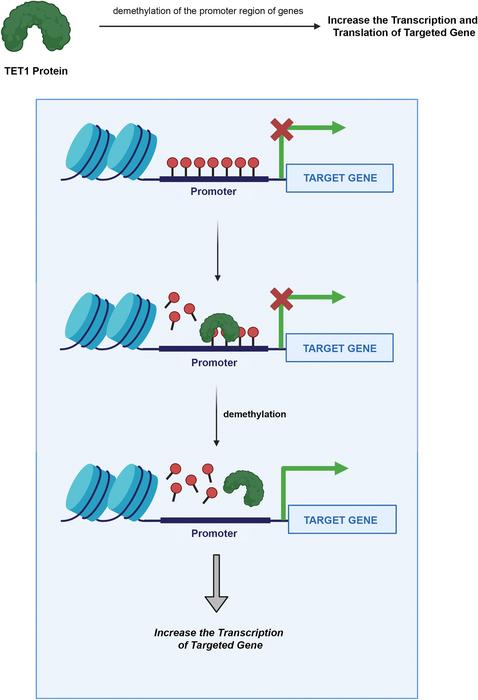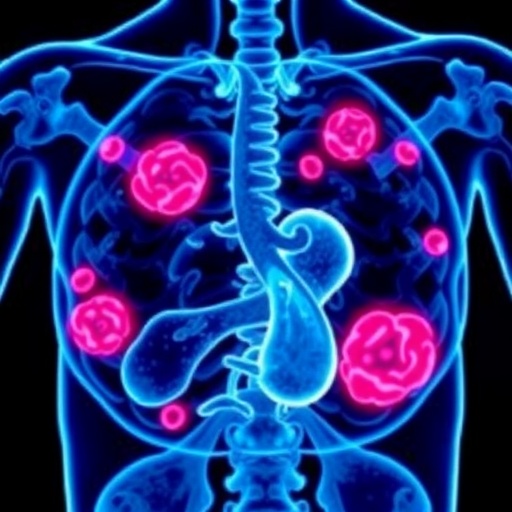Recent advances in molecular biology have spotlighted TET1, a crucial enzyme mediating DNA demethylation, as a central figure in the complex landscape of epigenetic regulation and disease progression. As an epigenetic architect, TET1 orchestrates gene expression by catalyzing the oxidation of 5-methylcytosine (5mC) to 5-hydroxymethylcytosine (5hmC), thereby initiating a cascade that ultimately leads to DNA demethylation in promoter regions. This enzymatic activity modulates the chromatin state, rendering genes accessible for transcriptional activation and profoundly influencing cellular fate decisions. The nuanced role of TET1 in controlling methylation dynamics represents a paradigm shift in understanding genome plasticity and its implications for human health.
Emerging research reveals TET1’s dichotomous function in oncogenesis, underscoring the enzyme’s adaptability within diverse cellular contexts. In certain malignancies, TET1 operates as a tumor suppressor by maintaining hypomethylated states of key tumor suppressor genes, thereby preventing their silencing and halting aberrant cellular proliferation. This tumor-suppressive activity involves intricate interplay with histone modifiers and transcription factors, establishing epigenetic landscapes that are unfavorable for cancer progression. Conversely, in other cancer subtypes, evidence suggests TET1 upregulation facilitates oncogenic pathways, promoting cellular proliferation, invasion, and metastasis, illustrating its paradoxical capacity to function as an oncogene under specific molecular cues.
Beyond its binary role in cancer, TET1 exerts profound influence on neurological functions, with dysregulation linked to a spectrum of neuropsychiatric and neurodegenerative disorders. In the central nervous system, TET1 modulates neural plasticity by regulating dynamic methylation marks at promoter regions of genes essential for synaptic function and memory consolidation. Perturbations in TET1 expression or activity have been implicated in pathologies such as schizophrenia, Alzheimer’s disease, and bipolar disorder, conditions characterized by disrupted epigenetic homeostasis. These findings underscore the enzyme’s pivotal role in maintaining cognitive integrity through epigenetic fine-tuning.
.adsslot_KysaqeWouC{ width:728px !important; height:90px !important; }
@media (max-width:1199px) { .adsslot_KysaqeWouC{ width:468px !important; height:60px !important; } }
@media (max-width:767px) { .adsslot_KysaqeWouC{ width:320px !important; height:50px !important; } }
ADVERTISEMENT
The metabolic domain also falls under the regulatory scope of TET1, where epigenetic modifications orchestrated by this enzyme influence key pathways governing energy homeostasis. TET1 has been shown to regulate genes involved in lipid metabolism and glucose uptake, thereby impacting the development of metabolic disorders including obesity and type 2 diabetes mellitus. The enzyme’s activity affects promoter methylation of metabolic regulators, modulating gene networks that determine adipogenesis, insulin sensitivity, and inflammatory responses—all critical in the pathophysiology of metabolic syndrome. This highlights TET1 as a potential molecular nexus connecting epigenetic control to metabolic health.
Immune regulation represents another frontier where TET1 exercises epigenetic governance, especially in the context of autoimmune and inflammatory diseases. By demethylating promoter regions of genes involved in immune cell differentiation and cytokine production, TET1 shapes the immune response landscape. Aberrant TET1 activity has been associated with pathological epigenetic remodeling in diseases such as rheumatoid arthritis and systemic sclerosis, where immune tolerance is disrupted. Through its modulation of both innate and adaptive immunity at the epigenetic level, TET1 contributes to the intricate balance between immune activation and suppression.
The multifaceted roles of TET1 across disease states have galvanized efforts toward developing therapeutics targeting its enzymatic function. Recent strides in the design of small molecule TET1 modulators aim to either inhibit or activate its demethylating activity, with the goal of restoring normal epigenetic patterns disrupted in disease. These pharmacological agents hold promise for precision medicine interventions, enabling targeted reprogramming of epigenetic states. While challenges remain in specificity and delivery, such approaches herald a new class of epigenome-based therapies poised to revolutionize treatment paradigms.
Mechanistically, TET1’s catalytic domain requires Fe(II) and α-ketoglutarate as cofactors to hydroxylate 5mC, implicating cellular metabolic states as modulators of its activity. This biochemical dependency integrates TET1’s function within the broader network of cellular metabolism, linking nutrient sensing and epigenetic regulation. Additionally, TET1 interacts with a suite of chromatin remodelers and transcriptional machinery, coordinating gene-specific demethylation events essential for cell identity and response to environmental stimuli. The spatial and temporal coordination of these interactions underscores the sophistication of TET1’s regulatory capacity.
Genomic studies further illuminate TET1’s role in genome stability, where maintaining appropriate methylation patterns prevents aberrant activation of transposable elements and oncogenes. Loss of TET1 function can lead to hypermethylation and silencing of tumor suppressor loci, promoting genomic instability and malignancy. Conversely, hyperactivity may result in oncogene activation, reflecting the dual-edged sword nature of its enzymatic action. Understanding the contextual cues dictating TET1’s functional directionality remains a central question in epigenetics and cancer biology.
In neuroscience, TET1 also modulates activity-dependent gene expression, notably influencing immediate early genes vital for synaptic plasticity. Animal models demonstrate that TET1 knockout results in impaired learning and memory, accompanied by altered methylation landscapes. These insights provide a molecular basis for cognitive deficits observed in psychiatric disorders and offer avenues for epigenetic-based therapeutic strategies aimed at restoring neural function.
From an immunological standpoint, TET1’s epigenetic control extends to shaping T-cell differentiation and macrophage activation states. By influencing methylation of lineage-specific genes, TET1 governs immune cell fate decisions and the balance between pro- and anti-inflammatory states. Such regulation is fundamental in maintaining immune homeostasis and preventing chronic inflammation underpinning autoimmune pathologies.
The convergence of TET1 research across oncology, neurology, metabolism, and immunology positions this enzyme as a master regulator of epigenetic landscapes pivotal to human health and disease. The ongoing elucidation of molecular mechanisms underlying TET1’s diverse functions continues to unravel intricate connections between epigenetic modification and cellular physiology. As epigenetic therapies advance, TET1 stands out as a promising biomolecular target with potential to transform precision medicine approaches.
Furthermore, the integration of high-throughput sequencing technologies and epigenome editing tools has accelerated the mapping of TET1’s genome-wide activity, revealing target gene networks and interactive partners. These technological innovations enable refined dissection of TET1’s role in distinct cellular contexts, facilitating biomarker discovery and informing therapeutic development. As the epigenetic field evolves, TET1 remains at the forefront, exemplifying the complexity and therapeutic potential of DNA methylation dynamics in clinical disease progression.
Subject of Research: TET1 enzyme and its role in epigenetic regulation of clinical diseases
Article Title: TET1: The epigenetic architect of clinical disease progression
News Publication Date: 2025
Web References: http://dx.doi.org/10.1016/j.gendis.2025.101513
References:
Keyvan Jabbari, Ali Khalafizadeh, Mahboubeh Sheikhbahaei, Hossein Soltaninejad, Sadegh Babashah, TET1: The epigenetic architect of clinical disease progression, Genes & Diseases, Volume 12, Issue 5, 2025, 101513.
Image Credits: Genes & Diseases
Keywords: Cancer genetics, Epigenetics, DNA demethylation, TET1, Neuroscience, Metabolic diseases, Autoimmune diseases, Epigenetic therapy
Tags: chromatin state modulation by TET1DNA methylation dynamics in healthepigenetic landscapes in malignanciesoncogenic functions of TET1role of TET1 in epigenetic regulationTET1 and cancer progressionTET1 as a tumor suppressorTET1 enzyme in DNA demethylationTET1 in cellular fate decisionsTET1 influence on gene expressionTET1 interactions withTET1’s role in genome plasticity





